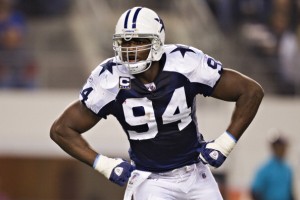In 2005, several key changes happened in Dallas. Bill Parcells was hired as head coach in ’03, but he didn’t implement a scheme shift right way. After Dallas ranked 27th in points allowed in ’04, though, changes were necessary. With two first round picks, the Cowboys selected 3-4 outside linebacker DeMarcus Ware and 3-4 defensive end Marcus Spears. Dallas also signed Jason Ferguson, who had played nose tackle for Parcells with the Jets. With the pieces in place, Dallas ran a 3-4 defense each of the last eight seasons. Ware has become one of, if not the, greatest 3-4 outside linebackers of all time. But after eight years of Parcells, Wade Phillips, and Rob Ryan, Dallas is returning to its 4-3 roots under Monte Kiffin.
Kiffin, of course, is most famous for the outstanding defenses that he and Tony Dungy created in Tampa Bay; the Tampa-2, after all, has became part of football nomenclature. But I don’t want to go into whether the Cowboys are well-positioned to switch fronts (they’re not) or who will play what role in 2013 (Ware and Anthony Spencer are moving to defensive end, Jay Ratliff will move from NT to DT, and newly rich Sean Lee will play as a true middle linebacker, and he might be even more valuable in this system). Instead, I want to take a 30,000 foot view.
In 1974, the 3-4 defense was introduced to the NFL by Bum Phillips in Houston, Lou Saban in Buffalo, and Chuck Fairbanks and Hank Bullough in New England. I thought it would be interesting to see how teams that switched fronts fared in their first season. On caveat: I wanted to exclude schizophrenic teams like the current Bills (4-3 defense in 2009, 3-4 in 2010, 4-3 in 2011 and 2012, and now a 3-4 again in 2013). According to my records, 74 teams in NFL history have switched from a 4-3 to a 3-4, or vice versa, after running the same front for the three prior years.
On average, how do these teams fair in year one of the switch? When I analyzed the performance of teams that hired head coaches with defensive backgrounds, I focused on points allowed and yards allowed, so let’s use those two metrics again. First, let’s look at teams who, like the 2013 Cowboys, switched from a 3-4 to a 4-3 defense. The most recent example is the 2012 Dolphins, who ranked 6th and 15th in points and yards allowed in 2011 while playing a 3-4, and then 7th and 21st in those categories as a 4-3 defense last season.
On average, these defenses weren’t too bad — they were just slightly below average in terms of both points and yards allowed (I would have expected to see these switches after some really bad seasons). On the other hand, the defenses barely improved, either. Had the average defense here been much poorer in Year N-1, we’d have to consider general regression to the mean principles. Here, though, these defenses were already around average (at least, on average). Changing defenses usually involves some growing pains, so perhaps these results are positive for Cowboys fans. The 2012 Cowboys were 24th in points allowed and 17th in yards allowed; I wouldn’t be too excited about a big jump just because of a switch in formation, but there doesn’t necessarily have to be growing pains, either.
What about defenses that switched from a 4-3 to a 3-4?
Well, this one looks better, but we still have to remember that there’s some regression to the mean at play here. What do you think of these results?
Previous “Random Perspective On” Articles:
AFC East: Buffalo Bills, Miami Dolphins, New England Patriots, New York Jets
AFC North: Baltimore Ravens, Cincinnati Bengals, Cleveland Browns, Pittsburgh Steelers
AFC South: Houston Texans, Indianapolis Colts, Jacksonville Jaguars, Tennessee Titans
AFC West: Denver Broncos, Kansas City Chiefs, Oakland Raiders, San Diego Chargers
NFC East: Dallas Cowboys, New York Giants, Philadelphia Eagles, Washington Redskins
NFC North: Chicago Bears, Detroit Lions, Green Bay Packers, Minnesota Vikings
NFC South: Atlanta Falcons, Carolina Panthers, New Orleans Saints, Tampa Bay Buccaneers
NFC West: Arizona Cardinals, San Francisco 49ers, Seattle Seahawks, St. Louis Rams

